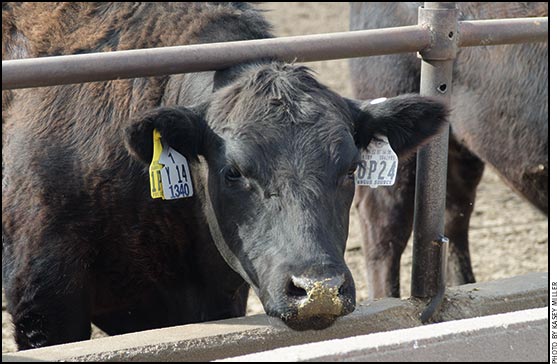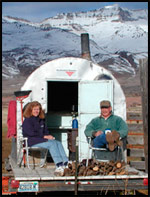MANAGEMENT...

Feedlot, Beef Industry Efficiency
Not The Same
Beef industry can modify its production system to be less reliant on grain.
For many years, cheap grain meant almost anything that enhanced grain use and feedlot measures of technical efficiency were consistent with beef industry efficiency. This is no longer true.
“As feedlots feed animals placed at heavier weight, feed conversion on a per-pound-of-gain basis will increase, but overall industry use of grain will decrease,” said Derrell Peel, Oklahoma State University Cooperative Extension livestock marketing specialist. “This underscores the necessity to measure efficiency across the entire cattle industry and not just in the feedlot sector.” Read more.
Cow Temperament Affects Reproduction
Culling on temperament or adapting cattle to handling could help in maximizing reproductive performance in beef cows.
Sometimes we wonder if that cow rattling the chute is worth keeping. Recent research suggests maybe not, said Elaine Grings, South Dakota State University (SDSU) Extension cow-calf management and production specialist.
Grings points to studies conducted several years ago with Brahman-cross cattle revealing cows with excitable temperaments had lower pregnancy rates than their calmer herdmates. Oregon State University researchers Reinaldo Cooke, D.W. Bohnert, B.I Cappellozza, C.J. Mueller and T. DelCurto expanded the study to look at the effect of cattle temperament and acclimation to handling on reproductive performance in Angus ✕ Hereford-cross cows. Their results were reported in the October issue of the Journal of Animal Science (2012.90:3547-3555). Read more.

Ron Torell with his wife, Jackie
Cow Camp Chatter
Gestation and dystocia
Oftentimes when a first-calf heifer experiences calving difficulty we automatically cast all the blame on the immediate sire of the calf. We may forget that the sire contributes only half of the genetic merit. The pedigree of the dam determines the other half. If the dam’s pedigree is stacked with growth and large-birth-weight sires and dams, this is likely to influence calf delivery as a first-calf heifer. Conversely, if the dam’s pedigree is stacked with calving-ease sires and dams, one would expect shorter gestations, lower birth weights and less dystocia.
Information about gestation lengths of specific bulls are revealed when breeding and calving dates are documented from pasture-bred registered operations and/or artificial insemination (AI) breeding programs. Averaged together, the gestation length for all breeds of cattle is 283 days. The range is 279 days for Jersey up to 292 days for Brahman. On the average, the Continental breeds of Charolais, Simmental and Limousin exhibit gestation lengths of 289 days. English-bred cattle such as Angus, Shorthorn and Hereford exhibit shorter gestation lengths of 281, 282 and 285 days respectively. Within these breeds the average gestation length may vary an additional 12 days on either side of the average for the breed. Read more.

Kris Ringwall
Beef Talk
It’s all about DNA.
Life always has been about deoxyribonucleic acid, which commonly is called DNA. Early discussions about DNA were reserved for chemistry labs. However, as our scientific endeavors increased our understanding of DNA, the concept slowly gained in popular reading, and even grade school science books thoroughly cover the topic.
More recently, technical advances have allowed even more practical uses and applications of technologies that involve DNA. A case in point is that the beef industry now utilizes DNA technology to improve our understanding of beef animals.
Read more.
Ag Census Forms Due Feb. 4
Census information a vital tool for evaluating USDA programs
and services.
Ag Secretary Tom Vilsack continued to remind producers to complete forms for the Census of Agriculture, which are due Feb. 4. Speaking Jan. 14 to thousands of American farmers and ranchers in Nashville, Tenn., Vilsack said the Census of Agriculture is one of the most important tools for providing certainty to producers and sustaining the unlimited economic potential of rural America.
“It’s important for farmers and ranchers in America today to stand up and be counted by participating in the Census of Agriculture,” said Vilsack. “By participating in this survey, producers help provide a snapshot of the current state of agriculture in our country, which helps policymakers make better decisions about farm safety net programs and policies.” Read more.
New Products
Industry affiliates provide a wide array of products and services to assist you on the farm and ranch. Here's an assortment of new products to hit the market recently.
- Tractor relaunch
- Grange launches ebook
- Small animal waterer
- Enhanced overseeder
- New grapples and grinder
Angus Advisor
Click here for February herd management tips from cattle experts across the nation. Advice separated by region.
[Click here to go to the top of the page.]











